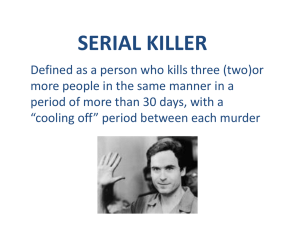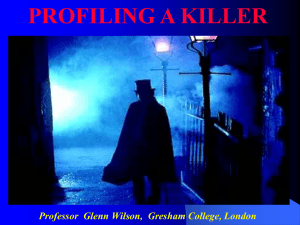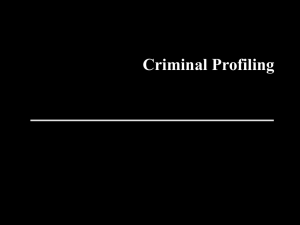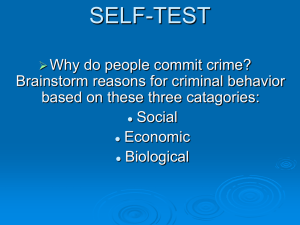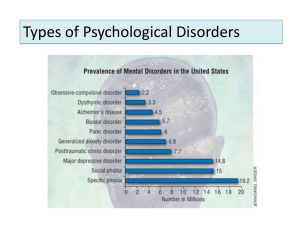Serial Killers - College of Saint Elizabeth
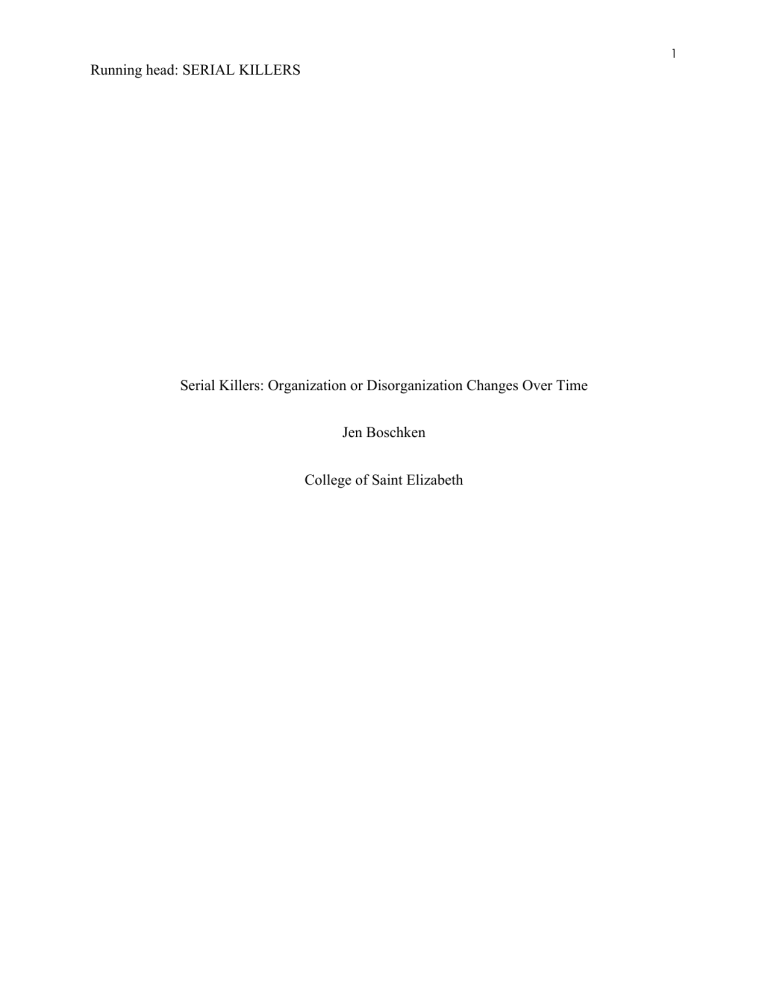
Running head: SERIAL KILLERS
Serial Killers: Organization or Disorganization Changes Over Time
Jen Boschken
College of Saint Elizabeth
1
SERIAL KILLERS
Abstract
Serial killers are people who killed more than three people during three or more instances.
Recent studies of serial killers categories have explored the classifications of organized and disorganized crime scenes based on the Federal Bureau of Investigations (FBI) classifications.
We hypothesize that over time serial killers would change their crime scene characteristics during their killing spree. The crime scenes of twenty-two serial killers were examined based on their organization in them. These data were imputed to give a mean score of 1.97 for the serial killers who become more organized and -0.71 for the ones who became more disorganized. It is concluded that there was a change in the organizational characteristics over the killing sprees.
Keywords: serial killers, crime, murder
2
3
SERIAL KILLERS
Serial Killers: Organization or Disorganization over Time
The Federal Bureau of Investigation (FBI) adopted a dichotomous classification of serial killers into the categories of either organized non-social or disorganized asocial (Federal Bureau of Investigation, 2005). There are, however, different views concerning what defines a serial killer. Canter and Wentink (2004) have defined a serial killer as an individual who has murdered three or more people over a period of more than a month with a ‘cooling off’ period between murders. For the FBI (2005) the unlawful killing of two or more victims by the same offender(s) in separate events works. The FBI offender profiling strategy is simple; it is based on the inclusion of a series of different crime scene, victim and personal traits of the offender that help to build a comprehensive profile of the murderer. Particular crime scene, victim and personal traits according to the FBI, appear to co-exist together, under either the organized or disorganized categories. For instance, organized serial killers plan the offense meticulously to the extent where the crime scene appears to be controlled so that there is very little if any incriminating evidence that police can use to capture them. The opposite is true of disorganized serial killers where the crime is spontaneous and the crime scene appears chaotic and filled with incriminating evidence.
There is continuing debate over criminal profiling and if there are different types of serial killers. To test this Canter and Wentick (2004) looked at the exclusivity of crime scene behaviors that were classified as organized or disorganized. They were particularly interested in finding empirical evidence of crime scene behaviors conclusively falling into the typology Holmes and
Holmes had come up with. This was done by testing the co-occurrence of specific characteristics across multiple serial killers. Canter and Wentick (2004) used a visual representation of the patterns of co-occurrence by using a multidimensional scale (MDS). The researchers used
SERIAL KILLERS information on crime scenes from 100 United States serial killings. The results found there was
4 high frequency of the characteristics from the power/control type of Holmes and Holmes’ typology.
Canter and Wenink (2004) found the mission killing type proved extremely difficult to relate to specific characteristics at the crime scenes except the weapon used to kill the victim. It was also found that it was difficult to distinguish this type of killing from the visionary type of killing. The three other types of killing visionary, lust and thrill were found to have limited support from the MDS analysis. The lack of support was assumed to be from the nature of the interactions with the victims instead of the interpretations of the motivations of the killers. The visionary killing is best distinguished in terms of the ransacking of the victim’s residence and the scattering of the victim’s clothing. The lust killings features formed a distinct region in the smallest space analysis (SSA) were dominated by mutilations to the victim’s body. For the thrill killings it was the restraints under which the victim was put that formed a distinct region.
Taylor, Lambeth, Green, Bone, and Chillane (2012) added to the research by examining the FBI’s organized and disorganized typologies of serial killers. The researchers looked at serial killers crime scenes and created a table documenting which criterion was found at each crime scene. In the study it was found that the groups were not entirely consistent with the criteria for organized and disorganized typologies the FBI used. Although there were many sets of criteria that fit within specific clusters of the typologies there were many outlying items found. This could be related to the fact that the researchers found both organized elements and disorganized elements in each of the crime scenes they studied for the research.
Taylor et at. (2012) concluded that most serial killings have an organized element for a murder to be successfully executed. This offers an explanation for the presence of organized
SERIAL KILLERS crime scene criteria among disorganized crime scene criteria. They found that it could be possible that different serial murders could be classified according to disorganized crime scene
5 criteria that commonly group together.
The FBI (2005) held a multidisciplinary symposium to have a common understanding of what makes a serial killer and the different types. They discovered that it is impossible to completely categorize and understand the motives of serial killers. The FBI defined three categories of killers based on the way they carry out each murder. The first category is the medical killer, this is the rarest. This type of killer feels they have the perfect cover because it is very common for people in a hospital or other medical facility to pass away. They are usually highly intelligent and understand how to take a life without it looking like a murder. As long as it appears that a victim died a natural death, there will be no reason for anyone to suspect foul play and search for the guilty party.
The next two categories discovered were the main focus of the FBI (2005) symposium.
The first is the organized killer who is the most difficult to identify and arrest. They are usually highly intelligent and well organized to the point of being meticulous. Every detail of the crime is planned out well in advance, and the killer takes every precaution to make sure they leave no evidence behind to link them to a murder. It is not uncommon for this type of serial killer to watch potential victims for several days in order to find someone they consider to be a good target. Once they choose the person, the killer will pick them up, often through some sort of trick that is designed to gain their sympathy, and take them to another location to commit the crime.
Once the person has been killed, the perpetrator will usually take precautions to ensure the body is not found. A criminal like this usually takes great pride in what they consider to be their
"work" and have a tendency to pay close attention to news stories about their crimes. One of
SERIAL KILLERS their motivating factors may be just to attempt to stump the law enforcement officers who are
6 trying to solve their crime.
The final category the FBI (2005) discovered was the disorganized killer who rarely plans out their kills. Most often, the people they kill just happen to be in the wrong place at the wrong time. This type of serial killer appears to strike at random whenever an opportunity arises.
They take no steps to cover up any signs of their crime, and tend to move to different towns or even states regularly to avoid being captured. Disorganized killers usually have low IQ's and are extremely antisocial. They rarely have close friends or family, and do not like to stay in one place for too long. These killers are prone to have no recollection of their criminal behavior, or to confessing that they were motivated by voices in their heads or some other imaginary source.
The research all revolves around the organized and disorganized crimes scenes and the different typologies for serial killers. Previous research examines if there is a way to categorize the killers into specific categories that describe the type of killing they carry out. It was discovered that there are some connections between the way the killings are committed and the categories already studied. However, there are many places in the typologies where there is no strong connection between crime scenes and typologies. Currently, there is a lack of research regarding how serial killers change over time and if their style of killing changes. The hypothesis for this study is that over time serial killers will change their characteristics throughout their killing spree.
SERIAL KILLERS
Method
Participants
The participants were twenty-two serial killers who had been arrested and convicted of three or more homicides committed on different days. The seventeenth serial killer was eliminated from the data because there was a lack of crime scenes compared to the rest of the serial killers.
Materials
7
The information about the crime scenes came from a variety of sources (i.e. books, news reports, and court documents). This information came from two books, Serial Killers (Innes,
2006) and The Encyclopedia of Serial Killers (Newton, 2006), and the Serial Killer Database created by Florida Gulf Coast University.
Procedure
The crimes of each serial killer were broken down based on each crime scene. This was done by looking through above materials and creating a table based on organizational traits of each crime scene.
Data preparation
We used event sampling, examining each individual crime scene. Each crime scene was coded based on eighteen criteria of organizational traits, restraints used, victim known, physical evidence, weapon planned, removal of body parts, torture, trophy taken, ritual aspect, sexualized body position, murder indoors, arson killer mobile/transit, body transported, staging, body disposal, process focused, poisoned, victim survived . The crime scenes of each serial killer were
SERIAL KILLERS score based on disorganization characteristics, 1 if the characteristic is present, 0 if the characteristic is not present. This was done for all twenty-two serial killers and each of their crime scenes. The eighteen organizational crime scene characteristics were put into an excel chart.
8
After coding all of the variables mentioned above, we then prepared these data for analysis. Of the eighteen variables two were reverse coded, physical evidence and victim survived .
Results
All of the composite scores of every crime scene from each serial killer were converted into a z-score by using the mean and standard deviation composite scores as the population parameter. The standardized scores were used to find the difference of organization from the first crime scene to determine the mean change scores. The mean change scores showed a change in the organization of crime scenes over the killing spree for each serial killer. The mean for the serial killers who became more organized was M=1.97 (SD=1.83). For the group of serial killers who became more disorganized throughout their killing spree the mean was M=-0.71 (SD=0.29).
Each of these showed a change in organization over the time of the killing spree for each serial killer, although the latter changed much less. The serial killer who showed the more organization change over time is shown in figure 1. In figure 2 the serial killer who became the most disorganized is shown.
Discussion
This study examined if there was a change in organization/disorganization in serial killers’ crime sprees. The researcher predicted that there was a noticeable change in either the
SERIAL KILLERS more organized or more disorganized direction for each serial killer. The results indicated that
9 there was a change in direction for each of the serial killers. The killers who became more organized throughout their killing spree seemed to change by a factor of two. This means that they changed the way they killed by two of the characteristics toward the more organized end of the spectrum. The killers who had characteristics of being more disorganized as their killing spree continued changed by a factor of one. Throughout their killing spree they tended to only change one of their organizational characteristic toward the disorganization end of the spectrum.
There are several limitations in this research. This study was primarily limited by its small sample size. The sample size could have been expanded by including a larger number of serial killers across the world and being limited to the United States. Another limitation for this study was the lack of information publically available about each crime scene and case for the serial killers. There were very few cases where the court transcripts are available or the serial killer details the events of each case.
The information gather from this study can help homicide investigators to determine what kind of serial killer they are tracking. For instance, serial killers who are more organized tend to be more meticulously at their crime scenes and leave very little incriminating evidence for police to use when tracking them. On the other hand, serial killers who are more disorganized kill more spontaneously and tend to leave the crime scene with incriminating evidence.
Examining if there was a change in organization over the killing spree is only the starting point for research on this topic. Future research on the topic could look at what causes the changes. This could include examining which serial killers tended to become more organized throughout their killing spree and what was happening around them during this time. Another
SERIAL KILLERS possible future research topic could be to examine how the mobility of the serial killer affected
10 the organization of their killing sprees.
SERIAL KILLERS
References
Aamodt, M. G. (2012). Serial Killer Information Center: Serial Killer Database. Radford
University.
Ahlers, M. Retrieved from http://www.cnn.com/2003/LAW/12/01/sprj.dcsp.malvo.trial/index.html
Aileen Carol Wuornos #805 . (n.d.). Retrieved from http://www.clarkprosecutor.org/html/death/US/wuornos805.htm
Albert DeSalvo Biography . (n.d.). Retrieved from http://www.biography.com/people/albert-desalvo-17169632
11
Angel Maturino Resendiz: the railroad killer (Documentary) [Video file]. (2013, June 21).
Retrieved from http://www.youtube.com/watch?v=f8_vTn1cDSY
Atlanta Journal-Constitution (2011, December 21). Cold case solved: girl, 13, was killed by serial killer in 1974 . Retrieved from http://www.ajc.com/news/news/local/cold-casesolved-girl-13-was-killed-by-serial-kill/nQPh4/
Ballamy, P. (n.d.). Robert D. Keppel Ph.D. An Interview by Patrick Bellamy? On the Trail of Ted
Bundy . Retrieved from http://www.crimelibrary.com/criminal_mind/profiling/keppel1/1.html
Bardsley, M. (n.d.). Angelo buono and kenneth bianchi, the hillside stranglers . Retrieved from http://www.crimelibrary.com/serial_killers/predators/stranglers/rampage_1.html
12
SERIAL KILLERS
Bardsley, M. (n.d.). Charles Manson and the Manson Family . Retrieved from http://www.crimelibrary.com/serial_killers/notorious/manson/murder_1.html
Bardsley, M. (n.d.). David berkowitz: The son of sam . Retrieved from http://www.crimelibrary.com/serial_killers/notorious/berkowitz/letter_1.html
Bardsley, M. (n.d.). Jeffrey dahmer: a victim almost escapes . Retrieved from http://www.crimelibrary.com/serial_killers/notorious/dahmer/index.html
Bardsley, M. (n.d.). The Boston strangler . Retrieved from http://www.crimelibrary.com/serial_killers/notorious/boston/index_1.html
Bell, R. (n.d.). Ted Bundy attack!
Retrieved from http://www.crimelibrary.com/serial_killers/notorious/bundy/index_1.html
Bell, R., & Bardsley, M. (n.d.). Too good to be true john wayne gacy jr . Retrieved from http://www.crimelibrary.com/serial_killers/notorious/gacy/3.html
Biography (n.d.). David berkowitz biography . Retrieved from http://www.biography.com/people/david-berkowitz-9209372
Biography (n.d.). Zodiac killer biography . Retrieved from http://www.biography.com/people/zodiac-killer-236027
Boston strangler DNA tests confirm Albert DeSalvo killed final victim . (2013, July 19). Retrieved from http://www.theguardian.com/world/2013/jul/19/boston-stranger-dna-test-albertdesalvo
SERIAL KILLERS
Bovsun, M. (2010, April 24). Date with the devil: 'Casanova killer' Paul John Knowles spared
13
Fleet Street reporter Sandy Fawkes . Retrieved from http://www.nydailynews.com/news/crime/date-devil-casanova-killer-paul-john-knowlesspared-fleet-street-reporter-sandy-fawkes-article-1.165401
Canter, D. V., & Wentink, N. (2004). An empirical test of Holmes and Holmes's serial murder typology. Criminal Justice and Behavior , 31 (4), 489-515. Retrieved from DOI:
10.1177/0093854804265179
CBS (n.d.). The Manson Family murders . Retrieved from http://www.cbsnews.com/pictures/themanson-family-murders/
CBS Los Angeles (2011, December 24). Sole survivor of notorious ?freeway killer? speaks out .
Retrieved from http://losangeles.cbslocal.com/2011/12/24/sole-survivor-of-notoriousfreeway-killer-speaks-out/
Chase, A. (2000, June). Harvard and the Making of the Unabomber . Retrieved from http://www.theatlantic.com/past/docs/issues/2000/06/chase.htm
CNN Library (2014, March 14). Manson Family Murders Fast Facts . Retrieved from http://www.cnn.com/2013/09/30/us/manson-family-murders-fast-facts/
Court refuses to hear mass murderer case. (1985, March 5). The Harlan Daily Enterprise
[Harlan], p. 10.
Crime Museum (n.d.). Crime library: Jeffrey dahmer . Retrieved from http://www.crimemuseum.org/crime-library/jeffrey-dahmer
14
SERIAL KILLERS
Drew, K. (2003, November 21). Teenager's sanity will be focus of second sniper trial . Retrieved from http://www.cnn.com/2003/LAW/11/16/sprj.dcsp.malvo.trial/
Edmund Kemper: The Co-ed Killer . (n.d.). Retrieved from http://www.crimeandinvestigation.co.uk/crime-files/edmund-kemper
Eighteenth Judicial District Court (2005). Transcript of pleas of guilty (05 CR 498).
Federal Bureau of Investigation (2005). Serial murder multi-disciplinary perspectives for investigators .
Federal Bureau of Investigation (n.d.). FBI ? Ted Bundy . Retrieved from http://vault.fbi.gov/Ted%20Bundy%20/
Florida bar, motel made famous by serial killer Aileen Wuornos attracts visitors from across country . (2013, January 9). Retrieved from http://www.nydailynews.com/news/national/public-fascinated-serial-killer-aileenwuornos-article-1.1236968
Full interview: Lee Boyd Malvo - The Washington Post . (n.d.). Retrieved from http://www.washingtonpost.com/posttv/local/full-interview-lee-boydmalvo/2012/09/29/26358730-098c-11e2-858a-5311df86ab04_video.html
Gacy sentenced to die for 33 deaths. (1980, March 14). Sarasota Herald-Tribune [Sarasota], pp. 1-8.
15
SERIAL KILLERS
Geringer, J. (n.d.). Angel Maturino Resendiz: the railroad killer . Retrieved from http://www.crimelibrary.com/serial_killers/notorious/resendez/track_1.html
Gribben, M. (n.d.). William Bonin: the freeway killer . Retrieved from http://www.crimelibrary.com/serial_killers/predators/bonin/day_1.html
Haines, M. (1982, May 1). John wayne gacy: buisnessman, clown, mass killer. The Citizen
[Ottawa], p. 100.
Innes, B. (2006). Serial killers . London: Quercus.
King, G. C. (n.d.). Robert Lee Yates Jr.,the Search for the Spokane serial killer . Retrieved from http://www.crimelibrary.com/serial_killers/predators/yates/bodies_1.html
Lee Boyd Malvo Biography - Facts, Birthday, Life Story . (n.d.). Retrieved from http://www.biography.com/people/lee-boyd-malvo-236005?page=1
Macleod, M. (n.d.). Aileen Wuornos: killer who preyed on truck drivers . Retrieved from http://www.crimelibrary.com/notorious_murders/women/wuornos/1.html
Making of a monster: Christopher Wilder (the beauty queen killer) . (2012, April 12). Retrieved from http://healthpsychologyconsultancy.wordpress.com/2012/08/12/making-of-amonster-christopher-wilder-the-beauty-queen-killer/
Malvo: Muhammad 'made me a monster' . (2006, May 26). Retrieved from http://www.cnn.com/2006/LAW/05/23/sniper.trial/index.html
SERIAL KILLERS
McLaughlin, E. C. (2010, March 3). Sniper's apology brings closure, no justice - CNN.com
.
16
Retrieved November 9, 2013, from http://www.cnn.com/2010/CRIME/03/04/malvo.sniper.confession/index.html?hpt=T1
Media shown car allegedly used in sniper shootings . (2003, November 26). Retrieved from http://www.cnn.com/2003/LAW/11/26/sprj.dcsp.car/
Montaldo, C. (n.d.). Son of sam killer david berkowitz . Retrieved from http://crime.about.com/od/murder/p/sonofsam.htm
Mount, H. (2006, May 25). The sniper's plan: kill six whites a day for 30 days . Retrieved from http://www.telegraph.co.uk/news/worldnews/northamerica/usa/1519411/The-snipers-plankill-six-whites-a-day-for-30-days.html
Murderpedia (n.d.). Kenneth Bianchi . Retrieved from http://murderpedia.org/male.B/b/bianchikenneth.htm
Newton, M. (n.d.). Randy Kraft, the Freeway Killer . Retrieved from http://www.crimelibrary.com/serial_killers/predators/kraft/1.html
Olsen, J., & Jesperson, K. H. (2003). I: The creation of a serial killer . New York, NY: St.
Martin's Paperbacks.
Ottley, T. (n.d.). Ted kaczynski: the unabomber . Retrieved from http://www.crimelibrary.com/terrorists_spies/terrorists/kaczynski/1.html
17
SERIAL KILLERS
Radford University (n.d.). Robert Lee Yates . Retrieved from http://maamodt.asp.radford.edu/Psyc%20405/serial%20killers/Yates,%20Robert%20Lee
.htm
Railroad killer executed in Texas . (2006, June 28). Retrieved from http://www.nbcnews.com/id/13579833/ns/us_news-crime_and_courts/t/railroad-killerexecuted-texas/
Ramsland, K. (n.d.). Christopher Wilder, sadistic serial killer of beauty pageant winners .
Retrieved from http://www.crimelibrary.com/serial_killers/predators/wilder/index.html
Ramsland, K. (n.d.). Edmund Kemper,: coed butcher . Retrieved from http://www.crimelibrary.com/serial_killers/predators/kemper/edmund_1.html
Ramsland, K. (n.d.). The crimes of John Paul Knowles: the Casanova Killer . Retrieved from http://www.crimelibrary.com/serial_killers/predators/john_paul_knowles/index.html
Robert Lee Yates-serial killer-documentary [Video file]. (2013, January 18). Retrieved from http://www.youtube.com/watch?v=UyIJMOkvT2E
Sager, I., & Stump, S. (2012, October 24). D.C. sniper Lee Boyd Malvo: I was sexually abused by my accomplice . Retrieved from http://www.today.com/news/d-c-sniper-lee-boyd-malvoi-was-sexually-abused-1C6671345
Secret Defense Plan of 'Beltway Sniper' Emerges . (2006, May 15). Retrieved from http://www.foxnews.com/story/2006/05/15/secret-defense-plan-beltway-sniper-emerges/
18
SERIAL KILLERS
Serial killer Robert Yates Jr. seeks federal appeal of death sentence . (2013, May 16). Retrieved from http://blogs.seattletimes.com/today/2013/05/serial-killer-robert-yates-jr-seeksfederal-appeal-of-death-sentence/
Son of D.C. Sniper John Allen Muhammad Lives in Dad's Shadow . (n.d.). Retrieved from http://web.archive.org/web/20110126153418/http:/abcnews.go.com/Nightline/son-dcsniper-lives-dads-shadow/story?id=10249182&page=2
Son Of Sam Speaks [Video file]. (2013, January 17). Retrieved from http://www.youtube.com/watch?v=4JepFcuZVuo
Stanglin, D. (2013, July 19). DNA test ties Albert DeSalvo to Boston strangler victim . Retrieved from http://www.usatoday.com/story/news/nation/2013/07/19/boston-strangler-albertdesalvo-dna-tests/2568599/
Supreme Court of California (1989). The people vs. richard ramirez (S012944).
Taylor, S., Lambeth, D., Green, G., Bone, R., & Cahillane, M. A. (2012). Cluster Analysis
Examination of Serial Killer Profiling Categories: A Bottom-Up Approach. Journal of
Investigative Psychology & Offender Profiling , 9 (1), 30-51. doi:10.1002/jip.149
Terry, D. (1994, November 29). Jeffrey Dahmer, Multiple Killer, Is Bludgeoned to Death in
Prison . Retrieved from http://www.nytimes.com/1994/11/29/us/jeffrey-dahmermultiple-killer-is-bludgeoned-to-death-in-prison.html
The Beltway Snipers . (2007, October 22). Retrieved from http://www.fbi.gov/news/stories/2007/october/snipers_102207
SERIAL KILLERS
The DC Sniper: The Beltway Sniper Attacks . (n.d.). Retrieved from http://www.crimemuseum.org/Washington_DC_Sniper
The Hillside Stranglers . (1984, January 9). Retrieved from http://www.history.com/this-day-inhistory/the-hillside-stranglers
19
The unabomber-ted kaczynski-documentary [Video file]. (2012, November 26). Retrieved from http://www.youtube.com/watch?v=o96XsGoWwSM
Three more bodies are found at home. (1978, December 24). Spartanburg Herald-Journal
[Spartanburg], p. 1.
Wark, J. (n.d.). The zodiac killer/zodiac murders . Retrieved from Crime Library website: http://www.crimelibrary.com/serial_killers/notorious/zodiac/river_1.html
Youngest sniper victim testifies . (2003, October 29). Retrieved from http://news.bbc.co.uk/2/hi/americas/3225817.stm
20
SERIAL KILLERS
Figure 1: Serial killer who showed the most change towards organization over the killing spree.
SERIAL KILLERS
Figure 2: Serial killer who showed the most change towards disorganization over the killing spree.
21

